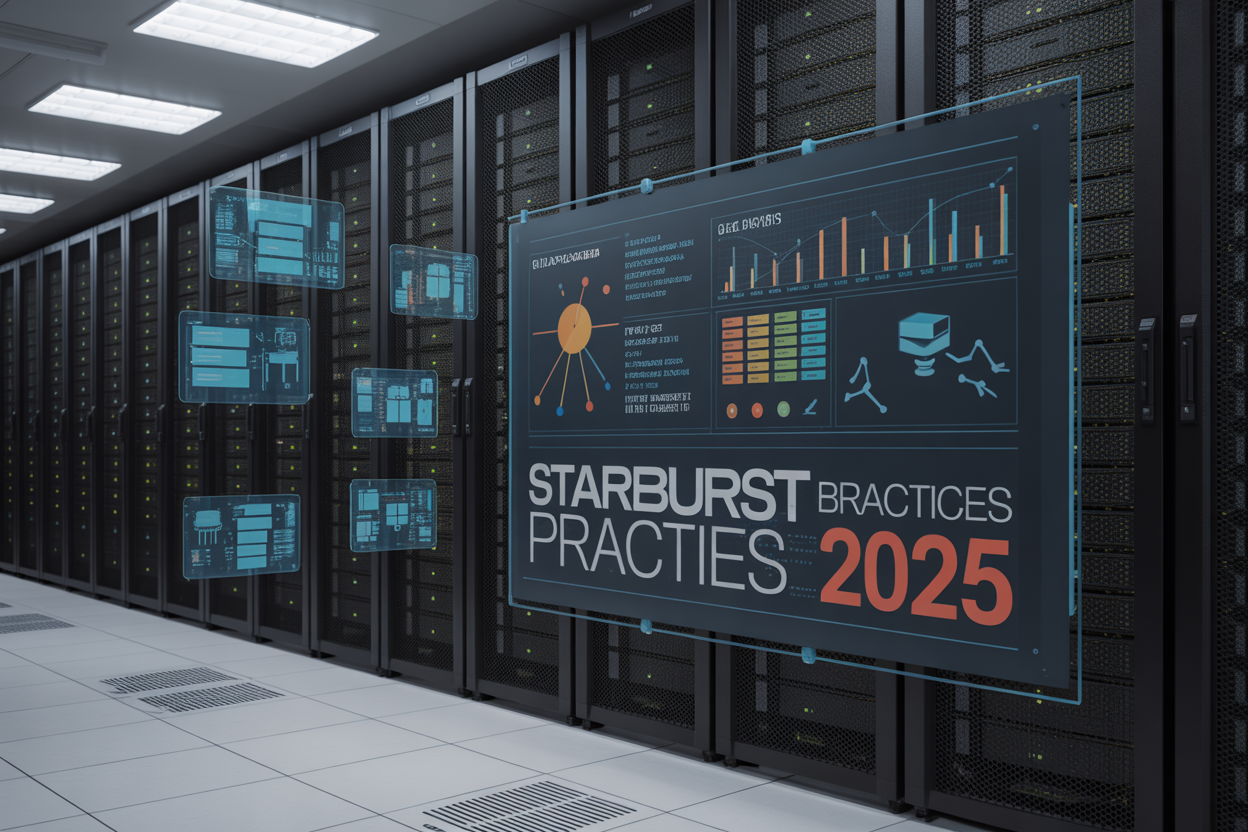Starburst has become the go-to solution for organizations managing complex data across multiple sources, but getting the most out of your deployment requires following proven strategies. This guide covers essential Starburst best practices for data engineers, platform administrators, and analytics teams looking to maximize performance and maintain clean, discoverable data environments in 2025.
Who This Guide Is For:
Data engineers building scalable analytics platforms, database administrators managing Starburst clusters, and data teams responsible for query performance and data governance.
What You’ll Learn:
We’ll walk through strategic naming conventions that make data discovery effortless across your organization. You’ll discover advanced Starburst query optimization techniques that can dramatically improve query performance and reduce resource consumption. Finally, we’ll cover how to implement a comprehensive data governance framework that keeps your data organized, secure, and compliant while supporting self-service analytics.
These practices will help you avoid common pitfalls, reduce troubleshooting time, and build a Starburst environment that scales with your organization’s growing data needs.
Strategic Naming Conventions for Enhanced Data Discovery

Implement Standardized Database and Schema Naming Patterns
Effective Starburst naming conventions start with clear database and schema patterns that make data discovery intuitive for your team. A well-structured approach uses prefixes that immediately communicate purpose and ownership. For production environments, consider patterns like prod_finance_reports, prod_marketing_analytics, or prod_customer_data to distinguish between business domains.
Development and staging environments benefit from consistent prefixes such as dev_, stage_, or test_ followed by the same domain structure. This creates predictable navigation paths that reduce confusion and speed up development cycles. Schema names should reflect both the data source and business function, like oracle_hr_payroll or postgresql_inventory_management.
Geographic or regional data often requires location identifiers: us_east_sales_data, eu_customer_profiles, or apac_marketing_campaigns. This geographical naming becomes crucial when managing compliance requirements across different regions.
Version control integration works best when schema names include meaningful version indicators. Instead of generic v1 or v2 suffixes, use date-based patterns like customer_data_2024q1 or feature-based naming such as sales_analytics_enhanced.
Establish Clear Table and Column Naming Guidelines
Table naming standards directly impact query performance and team productivity in Starburst environments. Descriptive table names eliminate guesswork and reduce documentation overhead. Instead of cryptic abbreviations like cust_ord_dtl, use explicit names like customer_order_details that immediately communicate content and purpose.
Consistent plural forms create predictable patterns. Tables containing multiple records should use plural nouns: customers, orders, products, transactions. This convention helps developers write intuitive JOIN statements without constantly checking table schemas.
Column naming requires special attention to data type clarity and business meaning. Avoid generic names like id, name, or date. Instead, use specific identifiers: customer_id, product_name, order_creation_date, last_update_timestamp. This specificity prevents JOIN ambiguities and makes self-documenting queries possible.
Boolean columns benefit from clear yes/no language: is_active, has_discount, was_shipped, can_return. Monetary columns should include currency context: price_usd, discount_amount_eur, tax_total_gbp. Date and timestamp columns need temporal context: created_at, updated_on, expires_after, valid_until.
Foreign key relationships become obvious with consistent suffixes. Use _id for single references and _ids for arrays: customer_id, product_category_id, tag_ids.
Create Consistent View and Materialized View Naming Standards
Views require distinct naming patterns that immediately communicate their purpose and underlying complexity. Simple aggregation views work well with descriptive prefixes: summary_monthly_sales, overview_customer_activity, report_quarterly_revenue. These names signal their role as reporting interfaces rather than raw data tables.
Complex analytical views benefit from function-based naming: forecast_demand_planning, analysis_customer_segmentation, model_churn_prediction. This approach helps data scientists and analysts quickly identify pre-built analytical assets.
Materialized views need special consideration due to their resource implications and refresh characteristics. Include refresh frequency in the naming: cache_daily_order_summary, snapshot_hourly_inventory_levels, buffer_realtime_user_activity. This naming pattern helps administrators manage refresh schedules and troubleshoot performance issues.
Security-filtered views should clearly indicate their access restrictions: secure_employee_data, filtered_customer_pii, masked_financial_records. These names immediately alert users to data sensitivity and compliance requirements.
Temporary or experimental views deserve their own namespace: temp_migration_test, experimental_ml_features, sandbox_data_quality_checks. This separation prevents accidental dependencies on unstable objects.
Develop Meaningful Catalog and Connector Naming Protocols
Starburst catalogs serve as the primary navigation interface for data discovery, making their naming critical for user adoption and efficiency. Business-aligned catalog names work better than technical ones. Instead of postgresql-prod-cluster-01, use names like customer-database, inventory-system, or financial-reporting.
Connector naming should reflect both the technology and business purpose: snowflake-analytics-warehouse, s3-data-lake-raw, mysql-ecommerce-transactional. This dual context helps users understand both the technical characteristics and business relevance of each data source.
Environment separation requires clear catalog naming patterns. Production catalogs might use simple business names: sales, marketing, finance. Development environments need obvious differentiation: sales-dev, marketing-staging, finance-test. This prevents accidental cross-environment data access and supports proper development workflows.
Multi-tenant environments benefit from organization-specific prefixes: acme-corp-sales, beta-inc-marketing, gamma-ltd-finance. This naming supports clear data isolation while maintaining intuitive navigation within each tenant’s scope.
Regional or compliance-specific catalogs need geographic or regulatory context: gdpr-compliant-customer-data, ccpa-filtered-user-profiles, sox-auditable-financial-records. These names immediately communicate compliance boundaries and access restrictions.
Advanced Query Optimization Techniques for Maximum Performance

Leverage Predicate Pushdown for Faster Data Filtering
Predicate pushdown stands as one of the most powerful Starburst query optimization techniques that dramatically reduces data movement across your network. This approach pushes filtering conditions down to the data source level, meaning your queries only retrieve the data they actually need rather than pulling everything into memory first.
When you write WHERE clauses in your queries, Starburst’s query planner automatically identifies which predicates can be pushed down to the underlying data sources. However, you can maximize this efficiency by structuring your queries strategically. Place your most selective filters first and avoid complex expressions that might prevent pushdown optimization.
Here’s what works best for predicate pushdown:
- Simple comparison operations (
=,>,<,>=,<=) - Range filters using
BETWEENstatements - IN clauses with literal values
- IS NULL and IS NOT NULL checks
Avoid functions in your WHERE clauses when possible, as they often block predicate pushdown. Instead of WHERE UPPER(column_name) = 'VALUE', consider creating computed columns or views with pre-processed data.
| Pushdown-Friendly | Blocks Pushdown |
|---|---|
WHERE date_col >= '2024-01-01' |
WHERE YEAR(date_col) = 2024 |
WHERE status IN ('active', 'pending') |
WHERE UPPER(status) = 'ACTIVE' |
WHERE amount BETWEEN 100 AND 1000 |
WHERE amount + tax > 1000 |
Optimize JOIN Operations Through Strategic Query Restructuring
Starburst performance tuning heavily depends on how you structure your JOIN operations. The query planner makes intelligent decisions about join order and strategy, but you can guide it toward optimal performance by understanding the underlying mechanics.
Start with your smallest tables first in multi-table joins. Starburst typically processes joins left-to-right, so placing dimension tables before fact tables often yields better performance. The engine can build hash tables from smaller datasets more efficiently, reducing memory pressure and execution time.
Consider these join optimization strategies:
- Use broadcast joins for small dimension tables (under 10MB)
- Partition your large tables on commonly joined columns
- Create bucketed tables when joining on the same columns repeatedly
- Avoid cross joins unless absolutely necessary
When dealing with multiple joins, break complex queries into smaller CTEs (Common Table Expressions). This approach makes your queries more readable and allows Starburst to optimize each CTE independently.
-- Optimized approach with CTEs
WITH filtered_orders AS (
SELECT order_id, customer_id, order_date
FROM orders
WHERE order_date >= '2024-01-01'
),
active_customers AS (
SELECT customer_id, customer_name
FROM customers
WHERE status = 'active'
)
SELECT o.order_id, c.customer_name, o.order_date
FROM filtered_orders o
JOIN active_customers c ON o.customer_id = c.customer_id
Implement Effective Partitioning and Bucketing Strategies
Smart partitioning forms the backbone of data lake optimization in Starburst environments. Your partitioning strategy should align with your most common query patterns, not just your data ingestion process.
Choose partition columns that appear frequently in your WHERE clauses. Date columns work exceptionally well for time-series data, while categorical columns like region or department suit analytical workloads. Avoid over-partitioning, which creates too many small files and overwhelms the metadata store.
Effective partitioning guidelines:
- Keep partition sizes between 100MB and 1GB
- Limit partition depth to 3-4 levels maximum
- Use consistent naming patterns across all partitioned tables
- Monitor partition pruning effectiveness through query plans
Bucketing complements partitioning by distributing data evenly within partitions. This technique proves especially valuable for JOIN-heavy workloads where you repeatedly join tables on the same columns.
-- Example bucketing strategy
CREATE TABLE sales_fact (
transaction_id BIGINT,
customer_id BIGINT,
product_id BIGINT,
sale_amount DECIMAL(10,2),
sale_date DATE
)
WITH (
partitioned_by = ARRAY['sale_date'],
bucketed_by = ARRAY['customer_id'],
bucket_count = 50
)
For Starburst scalability, consider implementing dynamic partitioning for tables with unpredictable partition patterns. This approach automatically creates partitions as new data arrives, reducing maintenance overhead while maintaining query performance.
Comprehensive Data Governance Framework Implementation

Establish Role-Based Access Control and Security Policies
Building a robust data governance framework starts with implementing comprehensive role-based access control (RBAC) within your Starburst environment. Create distinct user groups that align with your organization’s hierarchical structure and data access requirements. Define data analysts, engineers, business users, and administrators with specific permissions that match their job responsibilities.
Design security policies that operate at multiple levels: catalog, schema, table, and column. This granular approach ensures sensitive data remains protected while enabling legitimate business use. For financial data, restrict access to authorized personnel only, while allowing broader access to non-sensitive operational metrics.
Implement time-based access controls for temporary projects and contractor access. Set automatic expiration dates for user accounts to prevent security gaps when team members change roles or leave the organization. Regular access reviews should occur quarterly to validate that permissions remain appropriate.
Deploy Data Quality Monitoring and Validation Rules
Establish automated data quality checks that run continuously across your Starburst data sources. Create validation rules that verify data completeness, accuracy, consistency, and timeliness. Set up alerts when data quality metrics fall below acceptable thresholds.
Build custom quality checks for business-specific requirements. For example, validate that customer email addresses follow proper formatting, sales amounts fall within expected ranges, and required fields contain non-null values. Use Starburst’s built-in functions to create comprehensive validation queries that can be scheduled and monitored.
Implement data profiling processes that automatically generate quality reports for new datasets. Track data quality trends over time to identify patterns and potential upstream issues. Create dashboards that provide real-time visibility into data health across all connected sources.
Create Audit Trails and Compliance Tracking Systems
Develop comprehensive logging mechanisms that capture all user activities within your Starburst environment. Track query executions, data access patterns, schema modifications, and administrative actions. Store these logs in a secure, tamper-proof location with appropriate retention policies.
Build compliance reporting frameworks that align with industry regulations like GDPR, HIPAA, or SOX requirements. Automate the generation of compliance reports that demonstrate data access controls, retention policy adherence, and user activity monitoring. Create alerting systems that notify compliance teams of potential policy violations.
Establish clear audit trails for data modifications and transformations. Document who changed what data, when changes occurred, and the business justification for each modification. This documentation becomes critical during compliance audits and helps maintain data integrity across the organization.
Implement Data Lineage Documentation and Metadata Management
Create comprehensive data lineage maps that trace data flow from source systems through transformations to final consumption points. Use Starburst’s metadata APIs to automatically capture and maintain lineage information. This visibility helps teams understand data dependencies and impact analysis for changes.
Develop a centralized metadata repository that stores business definitions, data dictionaries, and technical documentation. Make this information easily searchable and accessible to all authorized users. Include data owner information, update frequencies, and quality indicators for each dataset.
Build automated processes that update lineage documentation as new data sources connect or transformation logic changes. Regular metadata validation ensures documentation remains accurate and current. Create visual representations of data flows that help non-technical stakeholders understand complex data relationships.
Develop Change Management Processes for Schema Evolution
Establish formal procedures for managing schema changes across your Starburst environment. Create approval workflows that require business and technical review before implementing structural modifications. Document the impact assessment process that evaluates how changes affect downstream systems and reports.
Implement version control practices for schema definitions and transformation logic. Maintain backward compatibility when possible, and provide clear migration paths when breaking changes are unavoidable. Create testing protocols that validate changes in isolated environments before production deployment.
Develop communication protocols that notify affected teams about upcoming schema changes. Provide advance notice with detailed documentation about modifications, timeline, and expected impact. Create rollback procedures that can quickly restore previous schema versions if issues arise after deployment.
Performance Monitoring and Troubleshooting Excellence

Configure Real-Time Query Performance Dashboards
Building effective real-time dashboards starts with collecting the right metrics from your Starburst cluster. The key performance indicators you should track include query execution time, memory usage, CPU utilization, and concurrent user sessions. Set up your dashboard to display these metrics with time-series charts that update every 30 seconds for optimal visibility into system performance.
Your dashboard should include separate panels for different performance aspects. Create dedicated views for query latency distribution, showing p50, p95, and p99 percentiles to understand performance across different query types. Add memory usage graphs that break down consumption by worker nodes and coordinator processes. Include network I/O metrics to spot data transfer bottlenecks between your Starburst cluster and underlying data sources.
Configure drill-down capabilities that let you investigate specific queries causing performance issues. When you spot a spike in execution time, you should be able to click through to see the actual SQL statement, execution plan, and resource consumption patterns. This granular visibility helps with quick root cause analysis.
Set up custom filters to focus on specific catalogs, schemas, or user groups. Different teams may have varying performance requirements, so create role-based dashboard views that highlight metrics relevant to each user group’s workloads.
Identify and Resolve Common Performance Bottlenecks
Memory pressure represents one of the most frequent performance challenges in Starburst environments. When queries exceed available memory limits, they either fail or spill to disk, dramatically slowing execution. Monitor your cluster’s memory usage patterns and identify queries that consistently consume excessive resources. Implement query memory limits and educate users on writing memory-efficient queries using appropriate JOIN orders and WHERE clause filtering.
Network latency between Starburst and your data sources creates another common bottleneck. This becomes particularly problematic when querying data across multiple cloud regions or when your Starburst cluster sits far from your data lake storage. Consider deploying Starburst clusters closer to your data sources or implementing data caching strategies for frequently accessed datasets.
Table scan operations without proper predicate pushdown often cause unnecessary performance degradation. Review your query execution plans to ensure filters are being pushed down to the data source level rather than being applied after data retrieval. This Starburst troubleshooting technique can reduce data transfer volumes by orders of magnitude.
Concurrent query limits and resource contention require careful monitoring. When too many resource-intensive queries run simultaneously, they compete for CPU, memory, and I/O bandwidth. Implement query queuing mechanisms and establish resource groups to prevent a few heavy queries from impacting overall system performance.
Worker node imbalances can create hotspots where some nodes handle disproportionate workloads while others remain underutilized. Monitor per-node metrics and investigate data distribution patterns that might cause uneven processing loads.
Implement Automated Alerting for System Health Monitoring
Design your alerting strategy around actionable thresholds rather than simple static limits. CPU utilization alerts should trigger not just when usage exceeds 80%, but when it remains elevated for sustained periods that indicate genuine performance issues. Create smart alerts that consider historical patterns and avoid false positives during expected peak usage times.
Set up cascading alert levels that escalate based on severity and duration. Warning-level alerts might notify your team about elevated query times, while critical alerts trigger when system components become unresponsive. Configure different notification channels for different alert types – send routine performance warnings to Slack channels while routing critical system failures to paging services.
Memory exhaustion alerts need careful calibration because memory usage can spike quickly during complex queries. Create alerts that monitor both absolute memory consumption and rate of change. A sudden memory increase might indicate a runaway query that needs immediate attention.
Query failure rate monitoring helps catch issues before they impact user experience. Set alerts when failure rates exceed baseline levels or when specific error types appear more frequently than normal. Include context about which catalogs or schemas are most affected to speed up troubleshooting.
Configure storage connectivity alerts to catch issues with your underlying data sources. S3 timeouts, HDFS connectivity problems, or database connection failures can cascade into widespread query failures. Early detection of these infrastructure issues helps your team respond proactively.
Create custom alerting rules for business-critical queries or scheduled jobs. These alerts should have tighter thresholds and faster response times since delays in essential data pipelines can impact downstream systems and reporting deadlines.
Scalability and Resource Management Best Practices

Optimize Cluster Configuration for Peak Performance
Getting your Starburst cluster configuration right makes all the difference between sluggish queries and lightning-fast results. The secret lies in matching your hardware resources to your workload patterns. Start by analyzing your query complexity and data volume to determine the optimal worker node count. For analytical workloads with complex joins, you’ll want more memory-heavy nodes, while simple aggregations benefit from CPU-optimized configurations.
Memory allocation deserves special attention in your Starburst resource management strategy. Set your JVM heap size to roughly 80% of available memory per worker, leaving room for off-heap operations and system processes. Configure the memory pool to handle your largest expected queries without triggering out-of-memory errors.
Network bandwidth often becomes the hidden bottleneck. Ensure your cluster nodes communicate over high-speed connections, ideally 10Gbps or higher for production environments. This prevents data shuffling operations from becoming performance killers during large table joins or aggregations.
Storage configuration impacts query performance significantly. Use local SSDs for spill operations and temporary data, while keeping your primary data on distributed storage systems like S3 or HDFS. This hybrid approach gives you the speed of local storage with the durability of distributed systems.
Implement Dynamic Resource Allocation Strategies
Dynamic resource allocation transforms how your Starburst deployment handles varying workloads throughout the day. Instead of running with fixed cluster sizes that waste resources during quiet periods, implement auto-scaling policies that respond to actual demand.
Set up resource groups to prioritize different workload types. Your real-time dashboard queries need immediate resources, while batch ETL processes can wait during peak hours. Configure queue limits and CPU time restrictions to prevent any single query from monopolizing cluster resources.
Memory isolation becomes critical when mixing workload types. Create separate resource pools for ad-hoc analytics, scheduled reports, and data transformation jobs. This prevents memory-intensive operations from starving other processes of resources.
Monitor query queuing patterns to identify scaling triggers. When average queue time exceeds your SLA thresholds, automatic scaling should kick in. Similarly, when resource utilization drops below defined levels for sustained periods, scale down to optimize costs.
| Resource Group | CPU Limit | Memory Limit | Queue Limit |
|---|---|---|---|
| Real-time Analytics | 50% | 40% | 10 queries |
| Batch Processing | 30% | 35% | 50 queries |
| Ad-hoc Queries | 20% | 25% | 20 queries |
Plan for Future Growth and Capacity Requirements
Capacity planning for Starburst scalability requires understanding your data growth patterns and user adoption trends. Track key metrics like daily query volume, average query complexity, and data ingestion rates to project future needs accurately.
Build growth models based on business drivers rather than simple linear extrapolation. If you’re launching new products or entering new markets, factor these initiatives into your capacity calculations. A 50% increase in users might translate to 200% more queries if new users run more complex analytics.
Storage growth patterns often follow different curves than compute requirements. While your data might grow steadily, compute needs tend to spike during business cycles, month-end reporting, or seasonal peaks. Design your architecture to handle these patterns independently.
Consider geographic distribution early in your planning process. As your organization grows globally, you’ll need regional Starburst clusters to minimize latency and comply with data residency requirements. Plan network connections and data replication strategies to support this distributed architecture.
Test your scaling assumptions regularly through load testing and capacity stress tests. Simulate peak conditions to validate that your scaling policies work as expected. This prevents surprises during actual high-demand periods when your business depends on reliable data access.
Keep technology evolution in mind when planning long-term capacity. New Starburst features, improved connector performance, and hardware advances can significantly change your resource requirements. Build flexibility into your architecture to take advantage of these improvements without major redesigns.

Following proper naming conventions, optimizing queries, and implementing strong data governance creates a solid foundation for any Starbucks deployment. These practices work together to make your data more discoverable, your queries faster, and your overall system more reliable. When you combine smart naming strategies with performance monitoring and resource management, you set your team up for long-term success.
The real value comes from treating these practices as an ongoing commitment rather than a one-time setup. Regular monitoring helps you catch performance issues early, while consistent governance keeps your data quality high. Start with the basics like standardized naming and query optimization, then gradually build out your governance framework. Your future self will thank you for the time invested in getting these fundamentals right from the start.




















